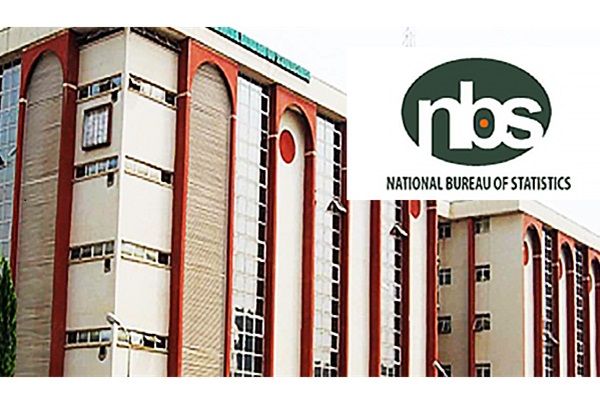According to data released yesterday by the National Bureau of Statistics (NBS), the unemployment rate in Nigeria rose from 5.0% in the third quarter of 2023 (Q3 2023) to 5.3% in the first quarter of 2024.
“The unemployment rate increased to 5.3percent in Q1 2024, from 5.0percent in Q3 2023. By place of residence, the rate was 6.0percent in urban areas and 4.3percent in rural areas for Q1 2024,” according to a statement released by NBS on “Nigeria’s Labour Force in Focus: NBS Published the 2023 Annual and Q1 2024 Labour Force Survey Results.”
The report also stated that the unemployment rate by educational status was as follows: the rate of unemployment among individuals with post-graduate education was 2.0 percent; the rate among those with post-secondary education was 9.0 percent; and the rate among those with secondary education was 6.9 percent.
According to NBS, the employment-to-population ratio was 73.2% in the first quarter of 2024.
According to the research, this represents a 2.4 percentage point drop from a ratio of 75.6 percent in Q3 2023.
NBS noted that the reports provide a comprehensive view of Nigeria’s labour market performance for the entire year 2023 and the first quarter of 2024, delivering essential insights into key labour market indicators.
The first of its kind, prepared in compliance with the guidelines of the International Labour Organisation (ILO) between the fourth quarter of 2022 and the third quarter of 2023, is the release of the annual report for 2023.
According to NBS, the results include comprehensive state-level statistics on important labour market indicators like youth participation in education, employment, or training, wage employment, underemployment, and unemployment.
Highlights of the NLFS 2023 Annual Report included the following information on the working-age population, as reported by NBS: 116.6 million people, or 53.8% of the total population, were working-age in 2023.
Males made up 48% of this population, while women made up 52%. Regarding the labour force participation rate, it was reported that the yearly rate was 76.3%, or 88.9 million people.
According to the survey, which broke down participation rates by state, Bauchi had the highest rate at 92.3 percent, while Ekiti had the lowest at 63.4 percent.
According to NBS, 20.6 million people between the ages of 15 and 24 made up the 84.1 million employed population out of all those of working age in 2023.
It also stated that, in terms of employment to population, rural areas (77.3%) outperformed urban areas (68.7%) in 2023, with the national employment-to-population ratio standing at 72.2%.
With 88.4% of the workforce employed, Bauchi had the highest ratio, while Rivers had the lowest, at 55.7%. Men’s EPR was 73.7 percent, while women’s EPR was 70.7 percent.
With an employment-to-population ratio of 88.4%, Bauchi had the highest ratio, while Rivers had the lowest at 55.7%. The EPR was 73.7 percent for males and 70.7 percent for females.
The report on informal employment stated that 77.6 million people, or 92.2 percent of the employed population, worked in informal employment during the reviewed year.
It stated: “Kano State had the highest number of informal workers, with about 5.2 million individuals engaged in informal employment, followed by Lagos State with 4.6 million people (excluding agriculture).
“On unemployment rate, it said the headline unemployment rate at the national level was 5.4per centin 2023. At the state level, Abia recorded the highest unemployment rate at 18.7per cent, while Nasarawa had the lowest at 0.5 per cent.”
NBS reported in terms of unemployment by educational status: In terms of educational attainment, the jobless rate was greatest at 9.4per cent among those with post-secondary education.
As per the survey, the next highest percentages were 6.7% for individuals with secondary education and 4.1% for those with primary education. It also mentioned that the lowest rate—3.2 percent—belonged to people without a formal education.
The statement further said: “Time-related underemployment: National time-related underemployment stood at 11.1per cent, with 8.3per cent for men and 13.4per cent for women. Plateau State had the highest time-related underemployment at 33.9per cent, while Nasarawa recorded the lowest at 0.3per cent.
“Youth not in employment, education, or training (NEET rate): The Youth NEET rate was 15.6per cent, with Abia State recording the highest NEET rate at 38.1per cent and Zamfara State the lowest at 4.5 per cent.”
The labour force participation rate was one of the Q1 2024 Labour Force Survey’s highlights. The working-age population’s labour force participation rate decreased to 77.3% in Q1 2024 from 79.5 percent in Q3 2023.
The statement reads in part: “Employment-to-population ratio: The employment-to-population ratio was 73.2per cent in Q1 2024. This is a decrease of 2.4 percentage points compared to a ratio of 75.6per cent in Q3 2023.
“The ratio in urban areas was 69.5per cent and 78.9per cent in rural areas in Q1 2024. This is a decrease in the ratio compared to the 71.1per cent and 80.7per cent in Q3 2023, respectively.
“Wage employment: The proportion of workers in wage employment rose to 16.0per cent in Q1 2024, a 3.3 percentage point increase from 12.7per cent in Q3 2023. By gender, 20.1per cent of males were in wage employment, compared to 12.1per cent of females. Wage employment was also higher in urban areas, at 21.8per cent than in rural areas, where it stood at 8.1per cent.
“Unemployment rate: The unemployment rate increased to 5.3per cent in Q1 2024, from 5.0per cent in Q3 2023. By place of residence, the rate was 6.0 per cent in urban areas and 4.3per cent in rural areas for Q1 2024.
“Unemployment by Educational Status: Unemployment based on educational attainment shows that the unemployment rate among persons with post-graduate education was 2.0 per cent, 9.0per cent among those with post-secondary education, 6.9per cent for those with secondary education, and 4.0per cent among those with primary education in Q1 2024.
“Youth Unemployment: The unemployment rate among youth aged (15-24 years) was 8.4 per cent in Q1 2024, a decrease of 0.2per cent compared to Q3 2023 (8.6per cent).
“Time-related underemployment: Time-related underemployment in Q1 2024 was 10.6per cent, showing a decrease of 1.7per cent from the rate of 12.3per cent recorded in Q3 2023.
“Youth not in employment, education, or training (NEET rate): The percentage of youth not in education, employment, or training (NEET rate) was 14.4 per cent in Q1 2024, showing a 0.7 percentage point increase from 13.7per cent in Q3 2023. The results also showed a higher NEET rate among females at 15.9per cent, compared to 13.0per cent for males in Q3 2023.
“Number of Hours Worked: Nationally, 1.5per cent of employed Nigerians spent between 1-9 hours in a week, 4.8per cent spent between 10-19 hours in a week, approximately 25per cent worked between 20-39 hours, 22per cent between 40-48 hours, and the 46per cent worked 48-hours and above in a week.”




